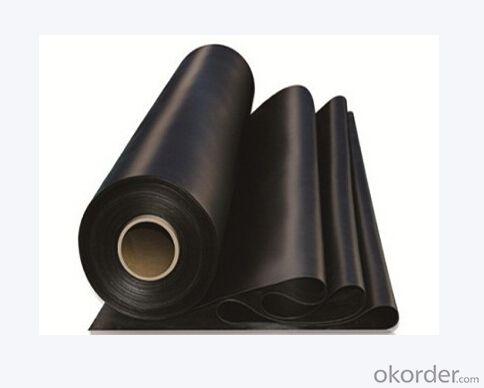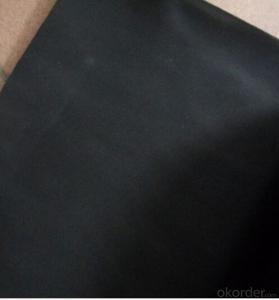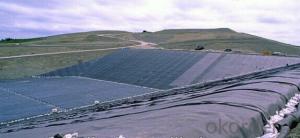Flexible 1M to 4M EPDM Waterproofing Membrane
- Loading Port:
- Qingdao
- Payment Terms:
- TT OR LC
- Min Order Qty:
- 2000 m²
- Supply Capability:
- 100000 m²/month
OKorder Service Pledge
OKorder Financial Service
You Might Also Like
EPDM Waterproof Membrane
1.Product Description
Flexible EPDM Waterproofing Membrane is the modified materials which is widely used at home and abroad in the kinds of roofs, tunnel, basement such sorts of constructions' waterproofing. They are based upon EPDM rubber with modifier, softener and accelerant assistants added to provide flexibility and stability . Through the precise ingredients, mixing, extrusion, rolling, curing processes to made of modified EPDM Waterproofing material with high strength and high flexibility.
2.Features
1. Great tensile strength,long-range elasticity and aging resistant.
2. Excellent heat reisistant and can be used under -70°C~~+110°C .
3.Good anti-corrosion, ultraviolet resistant, root penetration resistance
4.Long life use over 50 years and used longer 100 years or more under the condition of buried in the ground.
5.Light and easy to install.
3.Products Specification
Thickness : 0.3-2.0mm
Width :1m to 4m
Length: 15-100m/roll
Type | EPDM Waterproof Membrane | ||
Material | EPDM Rubber | ||
Thickness | 1.2mm | 1.5mm | 2.0mm |
Weight(kg/m2) | 1.54-1.58 | 1.79-1.83 | 2.25-2.29 |
Size | 1.2m(width) * 20m(length)/roll | ||
Type | Vulcanized & Weldable | ||
Pattern | Non-reinforced(homogeneous) | ||
Packing | 24sqm/roll, with plastic bag | ||
Color | Black | ||
Application | Roof, basement, pond, Lake, steel structure roof, swimming pool, underground, tunnel, etc | ||
4. Product Application:
(1) Roofs, Basement, Toilets
(2) Industrial and civil building waterproofing
(3) Geosynthetic liner for swimming pool, channels, irrigation system
(4) Especially suitable for projects with high requirements in durability, anti-corrosion and deformation

4. Some photos:



- Q:Are there any drawbacks or limitations to using a waterproofing membrane?
- Yes, there are some drawbacks and limitations to using a waterproofing membrane. One limitation is that it can be expensive to install, especially if it requires professional assistance. Additionally, if the membrane is not properly installed or maintained, it can become damaged or ineffective over time. Another drawback is that waterproofing membranes can limit the breathability of a structure, which can lead to moisture buildup and potential issues with mold or mildew. Finally, while a waterproofing membrane can protect against water intrusion, it may not fully address other potential sources of moisture, such as condensation or groundwater seepage.
- Q:Are waterproofing membranes resistant to thermal cycling?
- Yes, waterproofing membranes are generally resistant to thermal cycling. These membranes are designed to withstand changes in temperature without losing their effectiveness. Thermal cycling refers to the repeated expansion and contraction of materials due to temperature fluctuations. Waterproofing membranes are engineered to have excellent dimensional stability, which means they can expand and contract with minimal deformation. This resistance to thermal cycling ensures that the membranes maintain their integrity and prevent water penetration, even in extreme temperature conditions. However, it is important to note that the specific resistance to thermal cycling can vary depending on the type and quality of the waterproofing membrane used.
- Q:Is a waterproofing membrane resistant to solvents or chemical spills?
- Generally, waterproofing membranes tend to resist solvents and chemical spills. They are engineered to shield against water and other liquids, including solvents and chemicals. These membranes often consist of materials like PVC, TPO, or EPDM, which exhibit impressive resistance to different solvents and chemicals. Nevertheless, the degree of resistance can differ based on the membrane's type and composition. It is advisable to review the manufacturer's specifications and seek guidance from experts to confirm the membrane's compatibility with particular solvents or chemicals prior to installation.
- Q:Can a waterproofing membrane be applied to horizontal surfaces?
- Yes, a waterproofing membrane can be applied to horizontal surfaces.
- Q:Can waterproofing membranes be used on concrete tanks?
- Waterproofing membranes have the capability to be utilized on concrete tanks. These membranes are commonly employed in order to prevent water infiltration and safeguard concrete structures from water-related harm. Concrete tanks, much like other concrete structures, are vulnerable to water penetration over time, which can result in deterioration and structural problems. The application of a waterproofing membrane on the concrete surface can effectively obstruct water infiltration, thereby enhancing the tank's durability and prolonging its lifespan. A range of waterproofing membranes, including liquid-applied membranes, sheet membranes, and cementitious coatings, are available, each with its own unique advantages and suitability for different purposes. It is crucial to select the appropriate type of waterproofing membrane based on factors such as the tank's usage, exposure to water pressure, and environmental conditions. Additionally, proper surface preparation and application techniques play a significant role in ensuring the efficacy and longevity of the waterproofing membrane on the concrete tank.
- Q:Can a waterproofing membrane be used in renovation or retrofitting projects?
- Yes, a waterproofing membrane can definitely be used in renovation or retrofitting projects. In fact, it is often a critical component in such projects to ensure the long-term durability and protection of the building or structure. Waterproofing membranes are designed to create a barrier against moisture infiltration, preventing water damage, mold growth, and structural deterioration. During renovation or retrofitting, it is common to encounter issues like leaks, cracks, or deteriorated building materials that compromise the building's waterproofing system. In such cases, applying a waterproofing membrane over the affected areas can effectively seal and protect them from further damage. This can be done both on the interior and exterior of the building, depending on the specific requirements. Waterproofing membranes come in various forms, such as sheet membranes, liquid coatings, or spray-applied membranes. They can be applied to different surfaces like roofs, walls, basements, or even foundations. These membranes are flexible, durable, and resistant to water and other environmental stresses, making them ideal for renovation or retrofitting projects where there is a need to enhance the building's waterproofing capabilities. In conclusion, incorporating a waterproofing membrane in renovation or retrofitting projects is highly recommended to ensure the longevity and integrity of the building. It serves as a proactive measure to prevent future water damage, maintain structural stability, and improve the overall quality of the renovated or retrofitted space.
- Q:Does a waterproofing membrane prevent water infiltration through concrete or other building materials?
- Yes, a waterproofing membrane is designed to prevent water infiltration through concrete or other building materials. It acts as a protective barrier that is applied to the surface of the material, forming a water-resistant layer. This membrane can be made from various materials such as bitumen, rubberized asphalt, or liquid polymers. When properly installed, it can effectively prevent water from seeping through the concrete or other building materials, thus protecting the structure from potential water damage or moisture-related issues.
- Q:What is waterproofing membrane?
- Waterproof membrane requirements have good water resistance, stability of the temperature change (high temperature does not flow, no blistering, not confuse; low temperature does not brittle crack), a certain mechanical strength, extensibility and resistance to fracture, to There is a certain degree of flexibility and anti-aging and so on. The waterproofing membrane is a curlable sheet-like waterproofing material. Is one of the important varieties of waterproofing materials in construction engineering.
- Q:How does a waterproofing membrane handle expansion and contraction of the substrate?
- To effectively handle the expansion and contraction of the substrate, a waterproofing membrane is engineered to be flexible and elastic. It can stretch or shrink in accordance with temperature changes or other factors without experiencing any damage or failure. The flexibility of the membrane allows it to adapt to the movements of the underlying substrate, ensuring its integrity and complete functionality. This adaptability is achieved by utilizing materials with excellent elongation properties, such as modified bitumen, rubberized asphalt, or synthetic polymers like PVC or TPO. Moreover, a waterproofing membrane possesses a strong tensile strength, which enables it to withstand the stress caused by expansion and contraction without tearing or breaking. This strength is paramount in preventing water infiltration or moisture damage to the substrate. Additionally, during the installation of a waterproofing membrane, it is common practice to overlap or interlock the membrane sheets. These overlapping seams provide added protection against any potential substrate movement. If the substrate expands or contracts, the overlapping seams allow the membrane to accommodate the movement while maintaining a continuous and watertight barrier. In summary, a waterproofing membrane is specifically designed to effectively manage substrate expansion and contraction. Its flexibility, high tensile strength, and overlapping seams work together to ensure its durability, reliability, and efficacy in preventing water penetration, even as the substrate undergoes movement.
- Q:Can a waterproofing membrane be used on swimming pool decks?
- Indeed, swimming pool decks can benefit from the use of a waterproofing membrane. The purpose of these membranes is to effectively block water infiltration, which makes them particularly suitable for safeguarding areas that are constantly exposed to moisture, like swimming pool decks. Typically, these membranes are applied directly onto the deck's surface, creating an impermeable and long-lasting layer. This ensures that water does not permeate the deck, thus averting potential harm caused by dampness, such as cracks, the growth of mold, or structural decline. Furthermore, waterproofing membranes offer additional advantages, including prolonging the lifespan of the deck and enhancing its overall aesthetic appeal.
1. Manufacturer Overview |
|
|---|---|
| Location | |
| Year Established | |
| Annual Output Value | |
| Main Markets | |
| Company Certifications | |
2. Manufacturer Certificates |
|
|---|---|
| a) Certification Name | |
| Range | |
| Reference | |
| Validity Period | |
3. Manufacturer Capability |
|
|---|---|
| a)Trade Capacity | |
| Nearest Port | |
| Export Percentage | |
| No.of Employees in Trade Department | |
| Language Spoken: | |
| b)Factory Information | |
| Factory Size: | |
| No. of Production Lines | |
| Contract Manufacturing | |
| Product Price Range | |
Send your message to us
Flexible 1M to 4M EPDM Waterproofing Membrane
- Loading Port:
- Qingdao
- Payment Terms:
- TT OR LC
- Min Order Qty:
- 2000 m²
- Supply Capability:
- 100000 m²/month
OKorder Service Pledge
OKorder Financial Service
Similar products
New products
Hot products
Related keywords





























